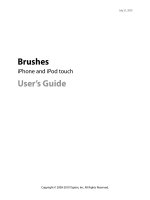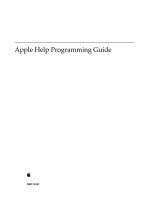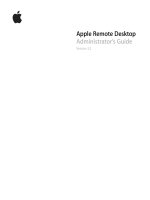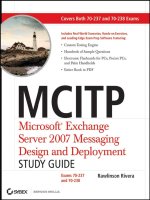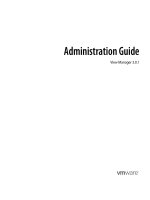iOS App Programming Guide phần 1 pptx
Bạn đang xem bản rút gọn của tài liệu. Xem và tải ngay bản đầy đủ của tài liệu tại đây (811.56 KB, 12 trang )
iOS App Programming Guide
General
2011-10-12
Apple Inc.
© 2011 Apple Inc.
All rights reserved.
No part of this publication may be reproduced,
stored in a retrieval system, or transmitted, in
any form or by any means, mechanical,
electronic, photocopying, recording, or
otherwise, without prior written permission of
Apple Inc., with the following exceptions: Any
person is hereby authorized to store
documentation on a single computer for
personal use only and to print copies of
documentation for personal use provided that
the documentation contains Apple’s copyright
notice.
The Apple logo is a trademark of Apple Inc.
No licenses, express or implied, are granted
with respect to any of the technology described
in this document. Apple retains all intellectual
property rights associated with the technology
described in this document. This document is
intended to assist application developers to
develop applications only for Apple-labeled
computers.
Apple Inc.
1 Infinite Loop
Cupertino, CA 95014
408-996-1010
App Store is a service mark of Apple Inc.
Apple, the Apple logo, AirPlay, Bonjour, Cocoa,
Instruments, iPhone, iPod, iPod touch, iTunes,
Keychain, Mac, Mac OS, Macintosh, Numbers,
Objective-C, Sand, and Xcode are trademarks
of Apple Inc., registered in the United States
and other countries.
iPad and Retina are trademarks of Apple Inc.
IOS is a trademark or registered trademark of
Cisco in the U.S. and other countries and is used
under license.
Intel and Intel Core are registered trademarks
of Intel Corporation or its subsidiaries in the
United States and other countries.
OpenGL is a registered trademark of Silicon
Graphics, Inc.
Times is a registered trademark of Heidelberger
Druckmaschinen AG, available from Linotype
Library GmbH.
UNIX is a registered trademark of The Open
Group
Even though Apple has reviewed this document,
APPLE MAKESNO WARRANTY OR REPRESENTATION,
EITHER EXPRESS OR IMPLIED, WITH RESPECT TO
THIS DOCUMENT, ITS QUALITY, ACCURACY,
MERCHANTABILITY, OR FITNESS FOR APARTICULAR
PURPOSE. AS A RESULT, THIS DOCUMENT IS
PROVIDED “AS IS,” AND YOU, THE READER, ARE
ASSUMING THE ENTIRE RISK AS TO ITS QUALITY
AND ACCURACY.
IN NO EVENT WILL APPLE BE LIABLE FOR DIRECT,
INDIRECT, SPECIAL, INCIDENTAL, OR
CONSEQUENTIAL DAMAGES RESULTINGFROM ANY
DEFECT OR INACCURACY IN THIS DOCUMENT, even
if advised of the possibility of such damages.
THE WARRANTY AND REMEDIES SET FORTH ABOVE
ARE EXCLUSIVE AND IN LIEU OF ALL OTHERS, ORAL
OR WRITTEN, EXPRESS OR IMPLIED. No Apple
dealer, agent, or employee is authorized to make
any modification, extension, or addition to this
warranty.
Some states do not allow the exclusion or limitation
of implied warranties or liability for incidental or
consequential damages, so the above limitation or
exclusion may not apply to you. This warranty gives
you specific legal rights, and you may also have
other rights which vary from state to state.
Contents
Introduction
About iOS App Programming 9
At a Glance 10
Translate Your Initial Idea into an Implementation Plan 10
UIKit Provides the Core of Your App 10
Apps Must Behave Differently in the Foreground and Background 10
iCloud Affects the Design of Your Data Model and UI Layers 11
Apps Require Some Specific Resources 11
Many App Behaviors Can Be Customized 11
Apps Must Be Tuned for Performance 11
The iOS Environment Affects Many App Behaviors 12
How to Use This Document 12
Prerequisites 12
See Also 12
Chapter 1
App Design Basics 15
Doing Your Initial Design 15
Learning the Fundamental iOS Design Patterns and Techniques 15
Translating Your Initial Design into an Action Plan 16
Starting the App Creation Process 17
Chapter 2
Core App Objects 21
The Core Objects of Your App 21
The Data Model 24
Defining a Custom Data Model 24
Defining a Structured Data Model Using Core Data 26
Defining a Document-Based Data Model 27
The User Interface 28
Building an Interface Using UIKit Views 28
Building an Interface Using Views and OpenGL ES 29
The App Bundle 30
Chapter 3
App States and Multitasking 35
Managing App State Changes 35
The App Launch Cycle 37
Responding to Interruptions 42
Moving to the Background 43
Returning to the Foreground 46
App Termination 48
3
2011-10-12 | © 2011 Apple Inc. All Rights Reserved.
The Main Run Loop 49
Background Execution and Multitasking 51
Determining Whether Multitasking Is Available 51
Executing a Finite-Length Task in the Background 52
Scheduling the Delivery of Local Notifications 53
Implementing Long-Running Background Tasks 54
Being a Responsible Background App 58
Opting out of Background Execution 59
Concurrency and Secondary Threads 60
Chapter 4
iCloud Storage 61
Design Considerations for iCloud Apps 61
Configuring Your App’s iCloud Entitlements 63
Using iCloud Document Storage 64
Determining if iCloud Document Storage is Available 66
Incorporating File Presenters into Your Workflow 66
Manipulating Files and Directories in iCloud 66
Choosing a Strategy to Respond to Version Conflicts 67
Incorporating Search into Your Infrastructure 68
Determining the Transfer Status of a File or Directory 69
Working With Files That Are Not Yet Downloaded 70
Updating Your User Interface for iCloud 70
Using iCloud in Conjunction with Databases 71
Using iCloud Key-Value Data Storage 74
Being a Responsible iCloud App 75
Chapter 5
App-Related Resources 77
App Store Required Resources 77
The Information Property List File 77
Declaring the Required Device Capabilities 78
Declaring Your App’s Supported Document Types 80
App Icons 81
App Launch (Default) Images 83
Providing Launch Images for Different Orientations 84
Providing Device-Specific Launch Images 85
Providing Launch Images for Custom URL Schemes 85
The Settings Bundle 86
Localized Resource Files 87
Chapter 6
Advanced App Tricks 89
Creating a Universal App 89
Updating Your Info.plist Settings 89
Implementing Your View Controllers and Views 90
4
2011-10-12 | © 2011 Apple Inc. All Rights Reserved.
CONTENTS
Adding Runtime Checks for Newer Symbols 91
Using Runtime Checks to Create Conditional Code Paths 91
Updating Your Resource Files 92
Preserving the State of Your App’s User Interface 92
Launching in Landscape Mode 93
Installing App-Specific Data Files at First Launch 94
Protecting Data Using On-Disk Encryption 94
Tips for Developing a VoIP App 95
Configuring Sockets for VoIP Usage 96
Installing a Keep-Alive Handler 97
Configuring Your App’s Audio Session 97
Using the Reachability Interfaces to Improve the User Experience 98
Communicating with Other Apps 98
Implementing Custom URL Schemes 99
Registering Custom URL Schemes 99
Handling URL Requests 100
Showing and Hiding the Keyboard 104
Turning Off Screen Locking 104
Chapter 7
Performance Tuning 105
Make App Backups More Efficient 105
What Is Backed Up? 105
Files Saved During App Updates 106
Use Memory Efficiently 106
Observe Low-Memory Warnings 107
Reduce Your App’s Memory Footprint 107
Allocate Memory Wisely 108
Move Work off the Main Thread 109
Floating-Point Math Considerations 109
Reduce Power Consumption 109
Tune Your Code 111
Improve File Access Times 111
Tune Your Networking Code 112
Tips for Efficient Networking 112
Using Wi-Fi 112
The Airplane Mode Alert 113
Appendix A
The iOS Environment 115
Specialized System Behaviors 115
The Virtual Memory System 115
The Automatic Sleep Timer 115
Multitasking Support 116
Security 116
The App Sandbox 116
5
2011-10-12 | © 2011 Apple Inc. All Rights Reserved.
CONTENTS
Keychain Data 117
Document Revision History 119
6
2011-10-12 | © 2011 Apple Inc. All Rights Reserved.
CONTENTS
Figures, Tables, and Listings
Chapter 2
Core App Objects 21
Figure 2-1 Key objects in an iOS app 22
Figure 2-2 Using documents to manage the content of files 27
Figure 2-3 Building your interface using view objects 29
Figure 2-4 Building your interface using OpenGL ES 30
Table 2-1 The role of objects in an iOS app 22
Table 2-2 Data classes in the Foundation framework 24
Table 2-3 A typical app bundle 31
Listing 2-1 Definition of a custom data object 25
Chapter 3
App States and Multitasking 35
Figure 3-1 State changes in an iOS app 36
Figure 3-2 Launching an app into the foreground 38
Figure 3-3 Launching an app into the background 39
Figure 3-4 Handling alert-based interruptions 42
Figure 3-5 Moving from the foreground to the background 44
Figure 3-6 Transitioning from the background to the foreground 46
Figure 3-7 Processing events in the main run loop 50
Table 3-1 App states 36
Table 3-2 Notifications delivered to waking apps 47
Table 3-3 Common types of events for iOS apps 50
Listing 3-1 The main function of an iOS app 40
Listing 3-2 Checking for background support in earlier versions of iOS 52
Listing 3-3 Starting a background task at quit time 52
Listing 3-4 Scheduling an alarm notification 53
Chapter 4
iCloud Storage 61
Figure 4-1 Pushing document changes to iCloud 65
Table 4-1 Differences between document and key-value storage 62
Chapter 5
App-Related Resources 77
Figure 5-1 Custom preferences displayed by the Settings app 86
Table 5-1 Dictionary keys for the UIRequiredDeviceCapabilities key 79
Table 5-2 Sizes for images in the CFBundleIconFiles key 82
Table 5-3 Typical launch image dimensions 83
Table 5-4 Launch image orientation modifiers 84
7
2011-10-12 | © 2011 Apple Inc. All Rights Reserved.
Chapter 6
Advanced App Tricks 89
Figure 6-1 Defining a custom URL scheme in the Info.plist file 100
Figure 6-2 Launching an app to open a URL 101
Figure 6-3 Waking a background app to open a URL 102
Table 6-1 Configuring stream interfaces for VoIP usage 96
Table 6-2 Keys and values of the CFBundleURLTypes property 99
Listing 6-1 Handling a URL request based on a custom scheme 103
Chapter 7
Performance Tuning 105
Table 7-1 Tips for reducing your app’s memory footprint 107
Table 7-2 Tips for allocating memory 108
Appendix A
The iOS Environment 115
Figure A-1 Sandbox directories in iOS 117
8
2011-10-12 | © 2011 Apple Inc. All Rights Reserved.
FIGURES, TABLES, AND LISTINGS
This document is the starting point for creating iOS apps. It describes the fundamental architecture of iOS
apps, including how the code you write fits together with the code provided by iOS. This document also
offers practical guidance to help you make better choices during your design and planning phase and guides
you to the other documents in the iOS developer library that contain more detailed information about how
to address a specific task.
The contents of this document apply to all iOS apps running on all types of iOS devices, including iPad,
iPhone, and iPod touch.
9
2011-10-12 | © 2011 Apple Inc. All Rights Reserved.
INTRODUCTION
About iOS App Programming
Note: Development of iOS apps requires an Intel-based Macintosh computer with the iOS SDK installed.
At a Glance
The starting point for any new app is identifying the design choices you need to make and understanding
how those choices map to an appropriate implementation.
Translate Your Initial Idea into an Implementation Plan
Every great iOS app starts with a great idea, but translating that idea into actions requires some planning.
Every iOS app relies heavily on design patterns, and those design patterns influence much of the code you
need to write. So before you write any code, take the time to explore the possible techniques and technologies
available for writing that code. Doing so can save you a lot of time and frustration.
Relevant Chapter: “App Design Basics” (page 15)
UIKit Provides the Core of Your App
The core infrastructure of an iOS app is built from objects in the UIKit framework. The objects in this framework
provide all of the support for handling events, displaying content on the screen, and interacting with the
rest of the system. Understanding the role these objects play, and how you modify them to customize the
default app behavior, is therefore very important for writing apps quickly and correctly.
Relevant Chapter: “Core App Objects” (page 21)
Apps Must Behave Differently in the Foreground and Background
An iOS device runs multiple apps simultaneously but only one app—the foreground app—has the user’s
attention at any given time. The current foreground app is the only app allowed to present a user interface
and respond to touch events. Other apps remain in the background, usually asleep but sometimes running
additional code. Transitioning between the foreground and background states involves changing several
aspects of your app’s behavior.
10
At a Glance
2011-10-12 | © 2011 Apple Inc. All Rights Reserved.
INTRODUCTION
About iOS App Programming
Relevant Chapter: “App States and Multitasking” (page 35)
iCloud Affects the Design of Your Data Model and UI Layers
iCloud allows you to share the user’s data among multiple instances of your app running on different iOS
and Mac OS X devices. Incorporating support for iCloud into your app involves changing many aspects of
how you manage your files. Because files in iCloud are accessible by more than just your app, all file operations
must be synchronized to prevent data corruption. And depending on your app and how it presents its data,
iCloud can also require changes to portions of your user interface.
Relevant Chapter: “iCloud Storage” (page 61)
Apps Require Some Specific Resources
There are some resources that must be present in all iOS apps. Most apps include images, sounds, and other
types of resources for presenting the app’s content but the App Store also requires some specific resources
be present. The reason is that iOS uses several specific resources when presenting your app to the user and
when coordinating interactions with other parts of the system. So these resources are there to improve the
overall user experience.
Relevant Chapter: “App-Related Resources” (page 77)
Many App Behaviors Can Be Customized
The core architecture of all apps may be the same, but there are still ways for you to tweak the high-level
design of your app. Some of these tweaks are how you add specific high-level features, such as data protection
and URL handling. Others affect the design of specific types of apps, such as VoIP apps.
Relevant Chapter: “Advanced App Tricks” (page 89)
Apps Must Be Tuned for Performance
Great apps are always tuned for the best possible performance. For iOS apps, performance means more than
just writing fast code. It often means writing better code so that your user interface remains responsive to
user input, your app does not degrade battery life significantly, and your app does not impact other system
resources. Before you can tune your code, though, learn about the types of changes that are likely to provide
the most benefit.
At a Glance 11
2011-10-12 | © 2011 Apple Inc. All Rights Reserved.
INTRODUCTION
About iOS App Programming
Relevant Chapter: “Performance Tuning” (page 105)
The iOS Environment Affects Many App Behaviors
There are aspects of iOS itself that impact how you design and write applications. Because iOS is built for
mobile devices, it takes a more active role in providing security for apps. Other system behaviors also affect
everything from how memory is managed to how the system responds to hardware input. All of these system
behaviors affect the way you design your apps.
Relevant Appendix: “The iOS Environment” (page 115)
How to Use This Document
This document provides important information about the core objects of your app and how they work
together. This document does not address the creation of any specific type of iOS app. Instead, it provides
a tour of the architecture that is common to all iOS apps and highlights key places where you can modify
that architecture to meet your needs. Whenever possible, the document also offers tips and guidance about
ways to implement features related to the core app architecture.
Prerequisites
This document is the main entry-point guide for designing an iOS app. This guide also covers many of the
practical aspects involved with implementing your app. However, this book assumes that you have already
installed the iOS SDK and configured your development environment. You must perform those steps before
you can start writing and building iOS apps.
If you are new to iOS app development and want an overview of iOS development process, including
information about how to configure your development environment, see App Development Overview.
See Also
For additional information related to app design, see the following documents:
● For guidance about how to design an iOS app, read iOS Human Interface Guidelines. This book provides
you with tips and guidance about how to create a great experience for users of your app. It also conveys
the basic design philosophy surrounding iOS apps.
● If you are not sure what is possible in an iOS app, read iOS Technology Overview. This book provides a
summary of iOS technologies and the situations where you might want to use them. This book is not
required reading but is a good reference during the brainstorming phase of your project.
12
How to Use This Document
2011-10-12 | © 2011 Apple Inc. All Rights Reserved.
INTRODUCTION
About iOS App Programming



